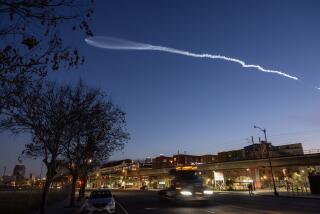Where Desert Meets the Sky : Base Has Clouds With Its Silver Lining
During months of debate over the closing of military bases across the country, the commanding general at Edwards Air Force Base went serenely about his job, never once worrying that the federal budget-cutting ax might fall on his neck.
When a Pentagon commission made its decisions earlier this month, Maj. Gen. John P. Schoeppner Jr. was proven correct. His Mojave Desert installation--the home of swift jets, first flights and test pilots--escaped unscathed.
Despite spiraling federal deficits, shrinking national defense budgets and an aerospace exodus from California, Schoeppner predicts a rosy future for the base where the sound barrier was broken and where space shuttles lumber out of the sky like albatrosses.
“We were never considered for closure. The base is so important to the national defense that you just could never close it,” said the general, 52, a former test-pilot-school graduate and Vietnam War fighter pilot.
“As long as we’re flying airplanes, Edwards will be the place,” he said.
Covering 470 square miles with 70 miles of runways, Edwards was designed by nature for experimental flying. Its wide open spaces, clear weather and long, flat runways make it perfect for the aerial contortions test pilots must throw their jets into, as well as providing a forgiving landscape if something goes wrong. Its dry lake beds are so soft that Air Force officials estimate they have saved at least $7-billion worth of aircraft in emergency landings over the years.
Edwards launches nearly 200,000 flight operations a year and its jets range more than 20,000 square miles of airspace, sometimes flying as low as 200 feet above the ground.
The facility is an economic anchor, contributing $1.8 billion to the economy in eastern Los Angeles County. Edwards is the largest employer in the Antelope Valley, with more than 15,000 workers and a $570-million payroll.
That’s the good news.
The base also faces some serious long-term threats. These include housing development that yearly creeps closer to flight routes, cracks in the famed clay runways, air pollution and a decaying infrastructure that caused a shocked Air Force chief of staff to comment to Schoeppner, “John, if this base was not so vital to the national defense, I’d recommend closing it.”
For now, base officials have been able to cope with these problems and keep the world’s most advanced aircraft flying.
In fact, virtually every Air Force aircraft flown in the Persian Gulf War, as well as most of those flown for the past four decades, were first put through their paces at Edwards’ Flight Test Center, the only one in the nation. The base also houses the Air Force’s test-pilot school, which graduates 50 pilots a year, and the lab where they are testing the next generation of space rockets, the Titan IV.
The U. S. military came to the area as far back as the 1930s for its isolation, clear flying weather, and its vast dry lake beds. The military used the area for gunnery practice during World War II and established an Army airfield there in 1946. Edwards Air Force Base was born three years later.
Schoeppner, an admitted optimist, believes those same characteristics that gave Edwards its start will assure its future, though he won’t be there to see it. The general is retiring Sept. 1 after a 31-year Air Force career, the past three years in the base’s top job, commander of the flight test center.
The recent recommendations by the government’s Defense Base Closure and Realignment Commission to close 34 bases and trim 48 others, proposals that are expected to be adopted, are likely to benefit Edwards somewhat, at least according to current military plans.
Edwards is slated within several years to get a new Air Force unit, the 4950th Test Wing with 24 aircraft and hundreds of personnel, from Wright-Patterson Air Force Base in Ohio. It is moving to make way for units from Rickenbacker Air National Guard Base in Ohio, which is being closed.
As the closures take effect, Edwards officials are hoping they may get other additions as well, though no other transfers have been announced. “Edwards is a logical spot to pick up things that can’t be done somewhere else,” said Bob Johnstone, one of Edwards’ top planners.
It is not that possibility, however, on which Edwards officials pin their future hopes. Instead, they forecast a continuing stream of flight-testing projects, including the B-2 bomber and the forthcoming Lockheed Advanced Tactical Fighter and McDonnell Douglas C-17 cargo plane.
Unlike most Air Force bases, which generally have only a few different types of aircraft and combat squadrons, Edwards is a research center with no combat units. Few of the 120 aircraft being tested there are alike and most have been customized for testing.
Nearly 40 years after the behemoth B-52 was put into service, crews at Edwards still work on improvements to the big bombers. Other crews are working on advances that will allow pilots to control their planes with voice commands.
Schoeppner said he also hopes proposals to build a pair of costly X-30 National Aero Space Planes will bring business to Edwards. The joint NASA-military project envisions a plane that could travel in space at up to 25 times the speed of sound but take off and land like a conventional jet.
In fact, despite the economic turmoil in the defense industry, the past several years have been the busiest in the history of Edwards. The base logged nearly 29,000 flight hours last year, because a number of new planes came on line, including the B-1B and new versions of the F-15 and F-16 fighters. Base officials predict a gradual decline to historic levels in the next few years as some testing projects wind down.
Years ago, few people lived in the vicinity of Edwards to care. But in recent years, development has come to the Kern County areas that surround the base, particularly in the town of Rosamond, which is 20 miles from the heart of the sprawling base but located just outside its western boundary.
Edwards officials fear that growth there and in nearby areas could impair, because of noise complaints, a variety of low-level flight routes. And noise isn’t only a local issue: Base spokesman Dennis Shoffner said one man in the Inyo County town of Lone Pine is so angry about overflight noise that he has talked of pressing a claim seeking $3 million for every resident there.
Edwards officials more than a year ago began talking with local jurisdictions about a joint land-use study that would limit future development around the base and under its flight paths. Johnstone, the base’s planner, said a contract to draw up the plan could be awarded later this year.
The counties and the cities that surround the base have been cooperative thus far, he said. But base officials worry when they look south to Air Force Plant 42, a 5,700-acre aircraft production facility that has had major battles with Palmdale and Lancaster over housing tracts being constructed nearby.
Another looming problem is the condition of the base’s lake beds, which has been getting progressively worse in recent years. Although cracks had been common, a huge one about half a mile long and four feet wide surfaced in January after heavy rains, forcing the closure of one runway.
Scientists believe falling ground-water levels in the region, caused by the pumping of water for municipal use, are causing the entire Antelope Valley to slowly sink, creating cracks both at Edwards and in Lancaster.
Thus far, Edwards officials have been able to work around and repair the problems. But a proposal to have the U. S. Geological Survey study the ground-water and cracking problems in the Antelope Valley--at a potential cost approaching $10 million--has stalled among local officials concerned about the expenditure.
Air pollution is another threat. In the 1960s, visibility at the base averaged more than 50 miles. But by 1986, the last time it was comprehensively measured, average visibility had dropped to about 33 miles, Johnstone said.
The base’s test flights often involve photographing jets at extreme distances, making visibility important. But Johnstone said the base has been losing some of that data on up to half of the flights being photographed.
And then there is the base’s notorious 1950s vintage infrastructure: leaky water mains, outdated electrical systems, old housing and hangars. Since his arrival, Schoeppner has moved aggressively to correct some of these problems. He said he would have given the base a D grade for its infrastructure when he arrived, and after three years of struggle and repair, possibly a C grade now.
More to Read
Sign up for Essential California
The most important California stories and recommendations in your inbox every morning.
You may occasionally receive promotional content from the Los Angeles Times.










